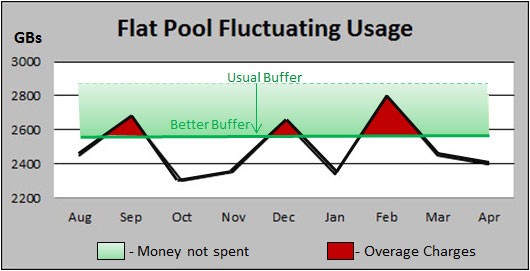While cost containment is likely at the core of every mobility management strategy, it’s the points of emphasis that define it. Where one company may consider a wireless device a perk with few restrictions, another company may extend service to the family members of its employees. Others may only assign devices to its critical employees heavily laden with limitations of use. MobilSense has outlined 10 dimensions describing the range of positions that might characterize a company’s culture and identity as it relates to mobility management. Click here to learn more.
Tag Archives: MobilSentry
Optimizing Invoices in Today’s Data-Centric Wireless World
 The concept of shifting away from voice-metered plans to data-metering first emerged in 2013. In the years since, most businesses have migrated to data pooling primarily because the carriers offer unlimited voice and messaging incentives for data-centric plans. Two general pooling plan types are offered today in the industry. Carriers like AT&T and Verizon offer you a choice of both pooling models while other carriers tend to focus on one variation or the other. To understand the economics of these two pooling models and make the best decisions for your company situation, it is important to appreciate the pros and cons of each model and know how to effectively project your data quantity needs in the pooling model you select.
The concept of shifting away from voice-metered plans to data-metering first emerged in 2013. In the years since, most businesses have migrated to data pooling primarily because the carriers offer unlimited voice and messaging incentives for data-centric plans. Two general pooling plan types are offered today in the industry. Carriers like AT&T and Verizon offer you a choice of both pooling models while other carriers tend to focus on one variation or the other. To understand the economics of these two pooling models and make the best decisions for your company situation, it is important to appreciate the pros and cons of each model and know how to effectively project your data quantity needs in the pooling model you select.
Understanding Pooling Types
The pooling models fall into what we call ‘Group Share’ and ‘Data Plus’ packages. Both offer unlimited voice and messaging with their unit of measure based on the number of gigabytes consumed. In the Group Share category, data is purchased in bulk quantities (10s to 100s of GB) with limits placed on the permitted number of devices within a group/pool. The Data Plus type plans either allow an unlimited number of devices or usage boundaries are sufficiently elevated to remove most practical limitations. Similar to how classic voice pools use to operate, Data Plus makes a small contribution (1 – 10 GB) toward the aggregate pool total from each device. To get to the total amount needed in a pool, you need to ensure the sum of all parts will achieve your predetermined goal.
MobilSentry™, a mobile expense management solution, can provide a platform for rate plan optimization and includes disciplines for determining which strategy is best for you. Click here to download our white paper, Optimizing Invoices in Today’s Data-Centric Wireless World.
Mobility Fraud, Abuse & Waste – The Sarbanes Oxley (SOX) Connection
 Sarbanes Oxley regulations passed by U.S. Congress in 2002 was designed to protect investors from fraudulent accounting activities by corporations. The intent of SOX is to detect and deter fraudulent or improper financial reporting by concentrating on issues related to the preparation of financial statements, issuer reporting/disclosure and audit failures. SEC Chairman, Mary Jo White introduced a policy to police technical, non-fraud violations. In explaining the policy, Chairman White stated, “minor deficiency violations that are overlooked or ignored and can feed bigger significant deficiencies, and, perhaps more importantly, can foster a culture where laws are increasingly treated as toothless guidelines”. The concept stems from the idea that even leaving small unaddressed discrepancies conveys a lack of importance and diligence to the maintenance of accurate reporting and accounting.
Sarbanes Oxley regulations passed by U.S. Congress in 2002 was designed to protect investors from fraudulent accounting activities by corporations. The intent of SOX is to detect and deter fraudulent or improper financial reporting by concentrating on issues related to the preparation of financial statements, issuer reporting/disclosure and audit failures. SEC Chairman, Mary Jo White introduced a policy to police technical, non-fraud violations. In explaining the policy, Chairman White stated, “minor deficiency violations that are overlooked or ignored and can feed bigger significant deficiencies, and, perhaps more importantly, can foster a culture where laws are increasingly treated as toothless guidelines”. The concept stems from the idea that even leaving small unaddressed discrepancies conveys a lack of importance and diligence to the maintenance of accurate reporting and accounting.
Out-of-control spending on mobility embodies an innate possibility of internal control deficiencies revealing instances that may rise to the level of material weakness requiring SEC filings and potential restatement of earnings. The opportunity to inadvertently misappropriate company funds presents itself daily and often goes unnoticed and why our utility customers use MobilSentry™ as a safeguard to protect their mobile assets. Click here to read our savings tip, The Threat of Out-of-Control Mobility Costs to Sarbanes Oxley Compliance.
